Implications of Corporate Collapses: A Case Study of Harris Scarfe
VerifiedAdded on 2023/06/04
|9
|2490
|445
AI Summary
This article discusses the implications of corporate collapses with reference to the case of Harris Scarfe. It covers issues related to audit committee, ethical issues, and auditor's independence. It also discusses the developments made following the collapse.
Contribute Materials
Your contribution can guide someone’s learning journey. Share your
documents today.
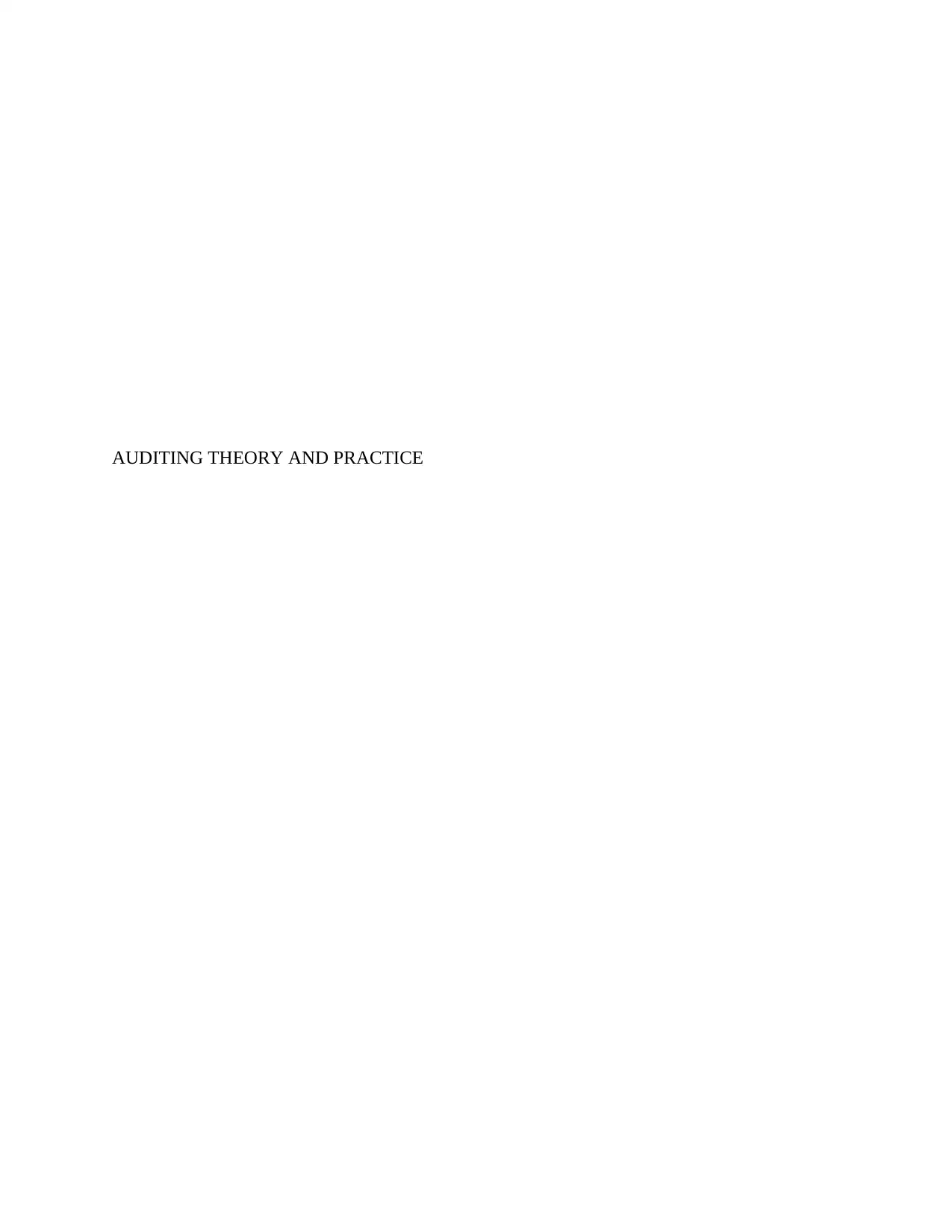
AUDITING THEORY AND PRACTICE
Secure Best Marks with AI Grader
Need help grading? Try our AI Grader for instant feedback on your assignments.

The corporate scandals in Australia during 2000 shook the public confidence and trust in the
accounting and auditing industry. The audit industry, as a result, decided to test all the
procedures and policies so as to understand the root of such scandals, that is, from where the
default is arising such as due to weak internal control, audit committee, ethical issues, absence of
professional conduct from auditors, management's responsibilities or the legal liability of auditor.
The following discussion is about implications of corporate collapses by having reference to the
case of Harris Scarfe which took place in 2001 and was collapsed with a debt of $265 million
dollars (Calderon, Song, & Wang, 2016).
The Harris Scarfe Limited not only suffered a severe decline but brought adverse impact on the
accounting & auditing profession. However, before discussing about the root causes and
initiatives taken, let us first have a discussion regarding the issues behind such a collapse. The
conflict arose in March in the company's stock position in the market. One of the main reasons of
its declining is the default in the setting of company’s records and picturing a fraud expression to
its stakeholders. It was a big question that why the company was never involved in any financial
problems and suddenly, it declared voluntary declaration in 2001 due to heavy cash flow
troubles. The statement made on this for explaining the conflict was that Hodgson used to make
a few book entries that inflated its stock price and resulted in rolling of profits (Jensen &
Meckling, 1976). But, when the trading didn't take place, he started making bigger entries and
that continuance led to cash flow problems. Basically, the company was involved in fraudulent
representation of higher profits. With this, we need to understand those roles that lacked
professionalism and ethical standards. However, our discussion requires the audit issues related
with such collapses. So let us discuss the audit issues with such a corporate scandal:
Audit Committee: Audit Committee is responsible for assisting the board of directors
regarding the financial information to be disclosed in the financial statements, preparation
and presentation of such financial information and monitoring & assisting the audit team
in their work. They are responsible for advising the BOD in fulfilling its responsibilities
towards its shareholders by providing them all the material information of the company
they have invested in whether in terms of finance or trust or both. It is basically
responsible for taking decisions such as nomination of auditor, scope of management's
responsibilities, etc. It regularly meets with the external auditor team to review their
accounting and auditing industry. The audit industry, as a result, decided to test all the
procedures and policies so as to understand the root of such scandals, that is, from where the
default is arising such as due to weak internal control, audit committee, ethical issues, absence of
professional conduct from auditors, management's responsibilities or the legal liability of auditor.
The following discussion is about implications of corporate collapses by having reference to the
case of Harris Scarfe which took place in 2001 and was collapsed with a debt of $265 million
dollars (Calderon, Song, & Wang, 2016).
The Harris Scarfe Limited not only suffered a severe decline but brought adverse impact on the
accounting & auditing profession. However, before discussing about the root causes and
initiatives taken, let us first have a discussion regarding the issues behind such a collapse. The
conflict arose in March in the company's stock position in the market. One of the main reasons of
its declining is the default in the setting of company’s records and picturing a fraud expression to
its stakeholders. It was a big question that why the company was never involved in any financial
problems and suddenly, it declared voluntary declaration in 2001 due to heavy cash flow
troubles. The statement made on this for explaining the conflict was that Hodgson used to make
a few book entries that inflated its stock price and resulted in rolling of profits (Jensen &
Meckling, 1976). But, when the trading didn't take place, he started making bigger entries and
that continuance led to cash flow problems. Basically, the company was involved in fraudulent
representation of higher profits. With this, we need to understand those roles that lacked
professionalism and ethical standards. However, our discussion requires the audit issues related
with such collapses. So let us discuss the audit issues with such a corporate scandal:
Audit Committee: Audit Committee is responsible for assisting the board of directors
regarding the financial information to be disclosed in the financial statements, preparation
and presentation of such financial information and monitoring & assisting the audit team
in their work. They are responsible for advising the BOD in fulfilling its responsibilities
towards its shareholders by providing them all the material information of the company
they have invested in whether in terms of finance or trust or both. It is basically
responsible for taking decisions such as nomination of auditor, scope of management's
responsibilities, etc. It regularly meets with the external auditor team to review their
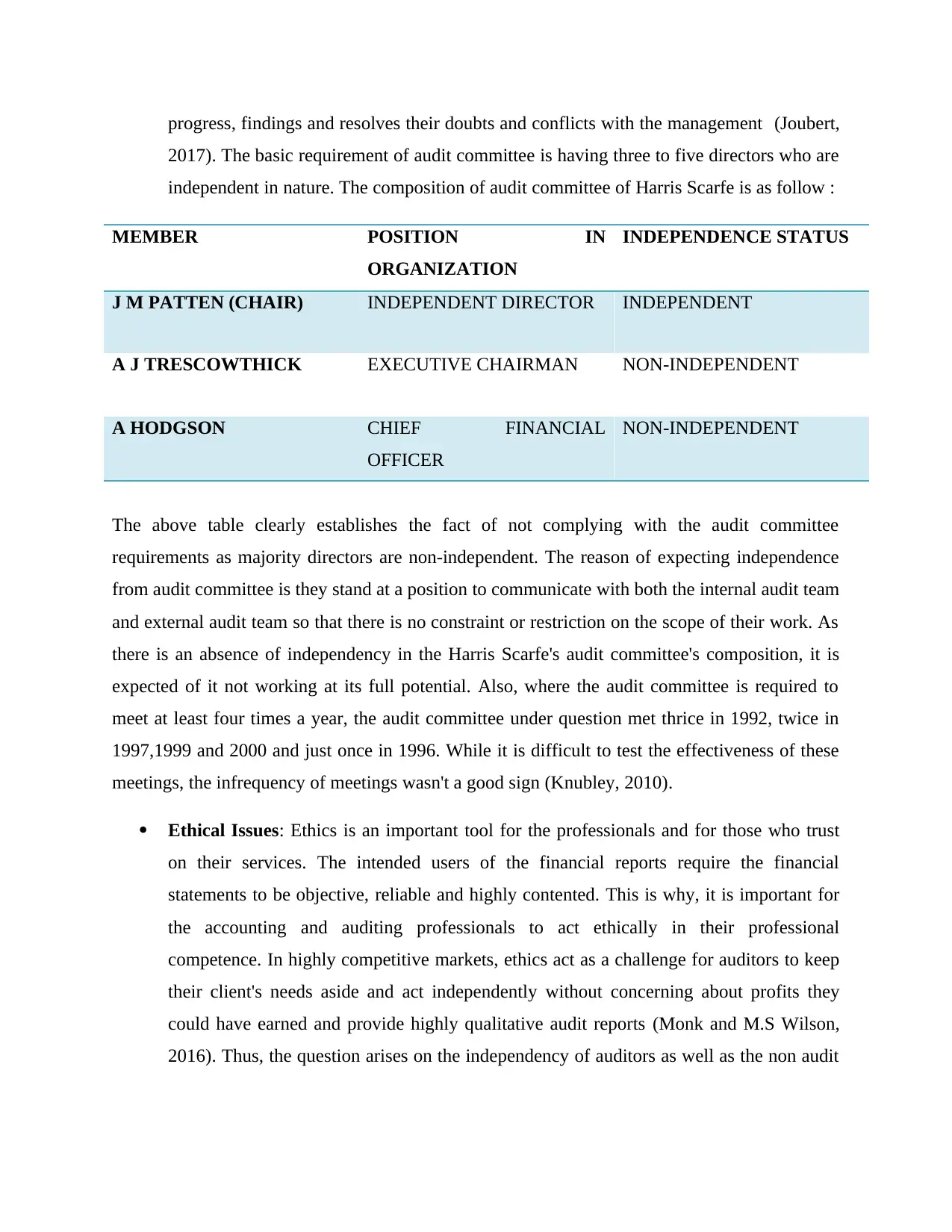
progress, findings and resolves their doubts and conflicts with the management (Joubert,
2017). The basic requirement of audit committee is having three to five directors who are
independent in nature. The composition of audit committee of Harris Scarfe is as follow :
MEMBER POSITION IN
ORGANIZATION
INDEPENDENCE STATUS
J M PATTEN (CHAIR) INDEPENDENT DIRECTOR INDEPENDENT
A J TRESCOWTHICK EXECUTIVE CHAIRMAN NON-INDEPENDENT
A HODGSON CHIEF FINANCIAL
OFFICER
NON-INDEPENDENT
The above table clearly establishes the fact of not complying with the audit committee
requirements as majority directors are non-independent. The reason of expecting independence
from audit committee is they stand at a position to communicate with both the internal audit team
and external audit team so that there is no constraint or restriction on the scope of their work. As
there is an absence of independency in the Harris Scarfe's audit committee's composition, it is
expected of it not working at its full potential. Also, where the audit committee is required to
meet at least four times a year, the audit committee under question met thrice in 1992, twice in
1997,1999 and 2000 and just once in 1996. While it is difficult to test the effectiveness of these
meetings, the infrequency of meetings wasn't a good sign (Knubley, 2010).
Ethical Issues: Ethics is an important tool for the professionals and for those who trust
on their services. The intended users of the financial reports require the financial
statements to be objective, reliable and highly contented. This is why, it is important for
the accounting and auditing professionals to act ethically in their professional
competence. In highly competitive markets, ethics act as a challenge for auditors to keep
their client's needs aside and act independently without concerning about profits they
could have earned and provide highly qualitative audit reports (Monk and M.S Wilson,
2016). Thus, the question arises on the independency of auditors as well as the non audit
2017). The basic requirement of audit committee is having three to five directors who are
independent in nature. The composition of audit committee of Harris Scarfe is as follow :
MEMBER POSITION IN
ORGANIZATION
INDEPENDENCE STATUS
J M PATTEN (CHAIR) INDEPENDENT DIRECTOR INDEPENDENT
A J TRESCOWTHICK EXECUTIVE CHAIRMAN NON-INDEPENDENT
A HODGSON CHIEF FINANCIAL
OFFICER
NON-INDEPENDENT
The above table clearly establishes the fact of not complying with the audit committee
requirements as majority directors are non-independent. The reason of expecting independence
from audit committee is they stand at a position to communicate with both the internal audit team
and external audit team so that there is no constraint or restriction on the scope of their work. As
there is an absence of independency in the Harris Scarfe's audit committee's composition, it is
expected of it not working at its full potential. Also, where the audit committee is required to
meet at least four times a year, the audit committee under question met thrice in 1992, twice in
1997,1999 and 2000 and just once in 1996. While it is difficult to test the effectiveness of these
meetings, the infrequency of meetings wasn't a good sign (Knubley, 2010).
Ethical Issues: Ethics is an important tool for the professionals and for those who trust
on their services. The intended users of the financial reports require the financial
statements to be objective, reliable and highly contented. This is why, it is important for
the accounting and auditing professionals to act ethically in their professional
competence. In highly competitive markets, ethics act as a challenge for auditors to keep
their client's needs aside and act independently without concerning about profits they
could have earned and provide highly qualitative audit reports (Monk and M.S Wilson,
2016). Thus, the question arises on the independency of auditors as well as the non audit

services provided by him or her whether it is compromising with the independence of the
auditor's role (Kusano, 2018).
Ernest & Young was replaced by Pricewaterhouse Coopers as Harris Scarfe's auditors in the year
1998. It was revealed that PWC received $120,000 for providing audit services while for non-
audit services, it received $211,284. Such non audit services were recorded as 'other services' in
the statements and the doubt arises when such other services were found unexplainable in the
reports. It is like the auditors who are expected to work in the best interest of shareholders are
performing such unexplainable services for their clients. Also, the suspicions arose about
whether such services have compromised with the auditor's independent nature or not.
Auditor’s Independence: The common liability of the audit firms was not being able to
trace the weakness of the company and was responsible for not acting with due care or in
their professional competence while performing their audit work. The claim was that the
auditors lacked control over their work and are responsible in a sense that they depended
themselves on the misstated financial information provided by the management. The
suspicion regarding auditor is that they failed to find the irregularities in the accounting
department. Also, they were expected to have compromised with their independence and
might have somewhere helped their client to represent fraudulent profits to enjoy the
benefits of a strong reputation in the market (Magazine, 2015).
However, an external auditor is not a guarantor but only provides reasonable assurance about the
financial statements that whether they are free of material misstatements. Preparation and
presentation of such financial statements is management's responsibility and the external auditor
has to rely on the information provided by them (Lyon, 2010). Thus, an expectation gap arose.
In the following case, the judgment declared was against the Chief Financial Officer (CFO) who
was sentenced to 6 years jail and the Chairman who was charged for acting fraudulently.
However, the audit firms wasn't found at guilt as giving true and fair financial information is the
duty of the management and the auditor's duty starts after that and ends with the reasonable
assurance provided by it. However, the court might not have found the audit team guilty but they
were responsible somewhere for not assessing the fraud.
auditor's role (Kusano, 2018).
Ernest & Young was replaced by Pricewaterhouse Coopers as Harris Scarfe's auditors in the year
1998. It was revealed that PWC received $120,000 for providing audit services while for non-
audit services, it received $211,284. Such non audit services were recorded as 'other services' in
the statements and the doubt arises when such other services were found unexplainable in the
reports. It is like the auditors who are expected to work in the best interest of shareholders are
performing such unexplainable services for their clients. Also, the suspicions arose about
whether such services have compromised with the auditor's independent nature or not.
Auditor’s Independence: The common liability of the audit firms was not being able to
trace the weakness of the company and was responsible for not acting with due care or in
their professional competence while performing their audit work. The claim was that the
auditors lacked control over their work and are responsible in a sense that they depended
themselves on the misstated financial information provided by the management. The
suspicion regarding auditor is that they failed to find the irregularities in the accounting
department. Also, they were expected to have compromised with their independence and
might have somewhere helped their client to represent fraudulent profits to enjoy the
benefits of a strong reputation in the market (Magazine, 2015).
However, an external auditor is not a guarantor but only provides reasonable assurance about the
financial statements that whether they are free of material misstatements. Preparation and
presentation of such financial statements is management's responsibility and the external auditor
has to rely on the information provided by them (Lyon, 2010). Thus, an expectation gap arose.
In the following case, the judgment declared was against the Chief Financial Officer (CFO) who
was sentenced to 6 years jail and the Chairman who was charged for acting fraudulently.
However, the audit firms wasn't found at guilt as giving true and fair financial information is the
duty of the management and the auditor's duty starts after that and ends with the reasonable
assurance provided by it. However, the court might not have found the audit team guilty but they
were responsible somewhere for not assessing the fraud.
Secure Best Marks with AI Grader
Need help grading? Try our AI Grader for instant feedback on your assignments.
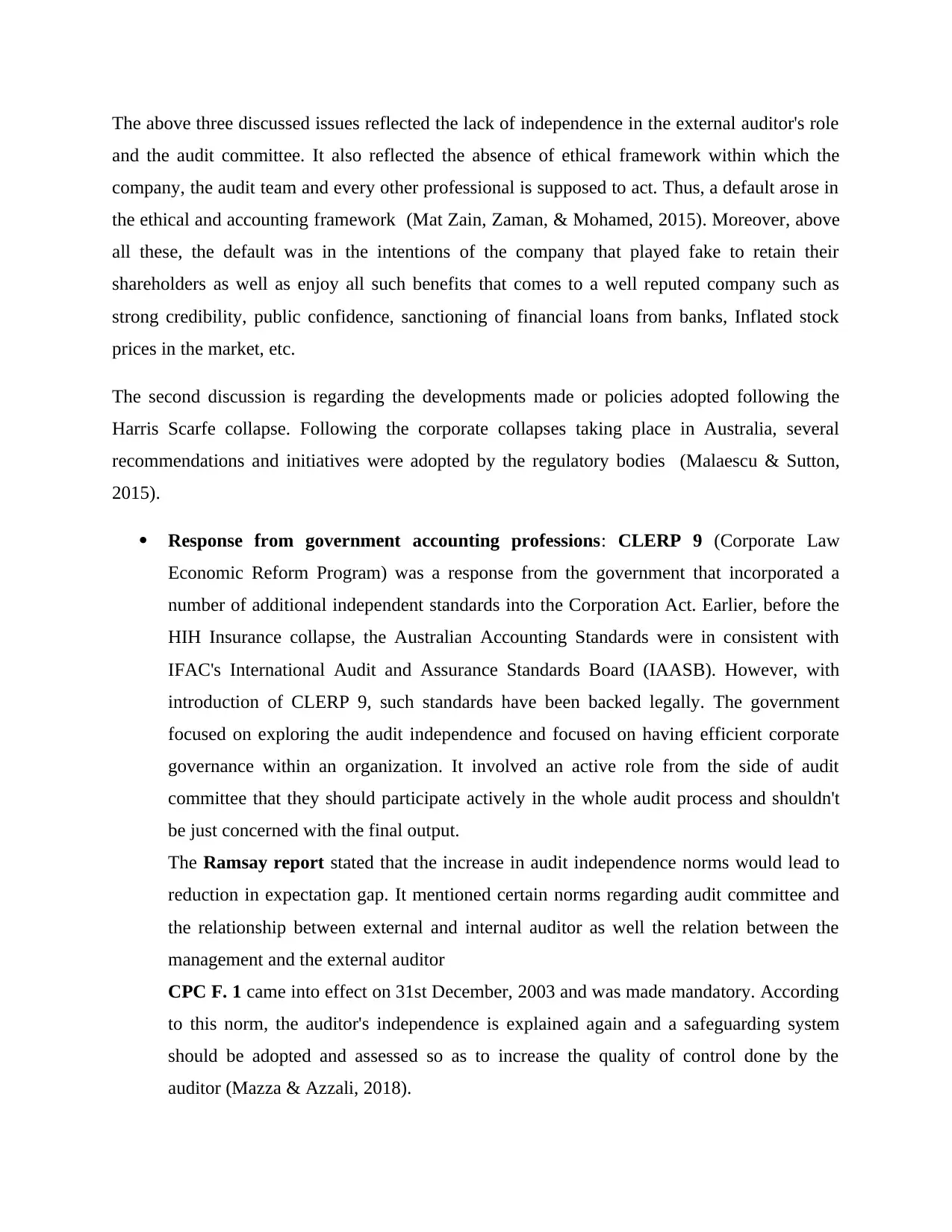
The above three discussed issues reflected the lack of independence in the external auditor's role
and the audit committee. It also reflected the absence of ethical framework within which the
company, the audit team and every other professional is supposed to act. Thus, a default arose in
the ethical and accounting framework (Mat Zain, Zaman, & Mohamed, 2015). Moreover, above
all these, the default was in the intentions of the company that played fake to retain their
shareholders as well as enjoy all such benefits that comes to a well reputed company such as
strong credibility, public confidence, sanctioning of financial loans from banks, Inflated stock
prices in the market, etc.
The second discussion is regarding the developments made or policies adopted following the
Harris Scarfe collapse. Following the corporate collapses taking place in Australia, several
recommendations and initiatives were adopted by the regulatory bodies (Malaescu & Sutton,
2015).
Response from government accounting professions: CLERP 9 (Corporate Law
Economic Reform Program) was a response from the government that incorporated a
number of additional independent standards into the Corporation Act. Earlier, before the
HIH Insurance collapse, the Australian Accounting Standards were in consistent with
IFAC's International Audit and Assurance Standards Board (IAASB). However, with
introduction of CLERP 9, such standards have been backed legally. The government
focused on exploring the audit independence and focused on having efficient corporate
governance within an organization. It involved an active role from the side of audit
committee that they should participate actively in the whole audit process and shouldn't
be just concerned with the final output.
The Ramsay report stated that the increase in audit independence norms would lead to
reduction in expectation gap. It mentioned certain norms regarding audit committee and
the relationship between external and internal auditor as well the relation between the
management and the external auditor
CPC F. 1 came into effect on 31st December, 2003 and was made mandatory. According
to this norm, the auditor's independence is explained again and a safeguarding system
should be adopted and assessed so as to increase the quality of control done by the
auditor (Mazza & Azzali, 2018).
and the audit committee. It also reflected the absence of ethical framework within which the
company, the audit team and every other professional is supposed to act. Thus, a default arose in
the ethical and accounting framework (Mat Zain, Zaman, & Mohamed, 2015). Moreover, above
all these, the default was in the intentions of the company that played fake to retain their
shareholders as well as enjoy all such benefits that comes to a well reputed company such as
strong credibility, public confidence, sanctioning of financial loans from banks, Inflated stock
prices in the market, etc.
The second discussion is regarding the developments made or policies adopted following the
Harris Scarfe collapse. Following the corporate collapses taking place in Australia, several
recommendations and initiatives were adopted by the regulatory bodies (Malaescu & Sutton,
2015).
Response from government accounting professions: CLERP 9 (Corporate Law
Economic Reform Program) was a response from the government that incorporated a
number of additional independent standards into the Corporation Act. Earlier, before the
HIH Insurance collapse, the Australian Accounting Standards were in consistent with
IFAC's International Audit and Assurance Standards Board (IAASB). However, with
introduction of CLERP 9, such standards have been backed legally. The government
focused on exploring the audit independence and focused on having efficient corporate
governance within an organization. It involved an active role from the side of audit
committee that they should participate actively in the whole audit process and shouldn't
be just concerned with the final output.
The Ramsay report stated that the increase in audit independence norms would lead to
reduction in expectation gap. It mentioned certain norms regarding audit committee and
the relationship between external and internal auditor as well the relation between the
management and the external auditor
CPC F. 1 came into effect on 31st December, 2003 and was made mandatory. According
to this norm, the auditor's independence is explained again and a safeguarding system
should be adopted and assessed so as to increase the quality of control done by the
auditor (Mazza & Azzali, 2018).
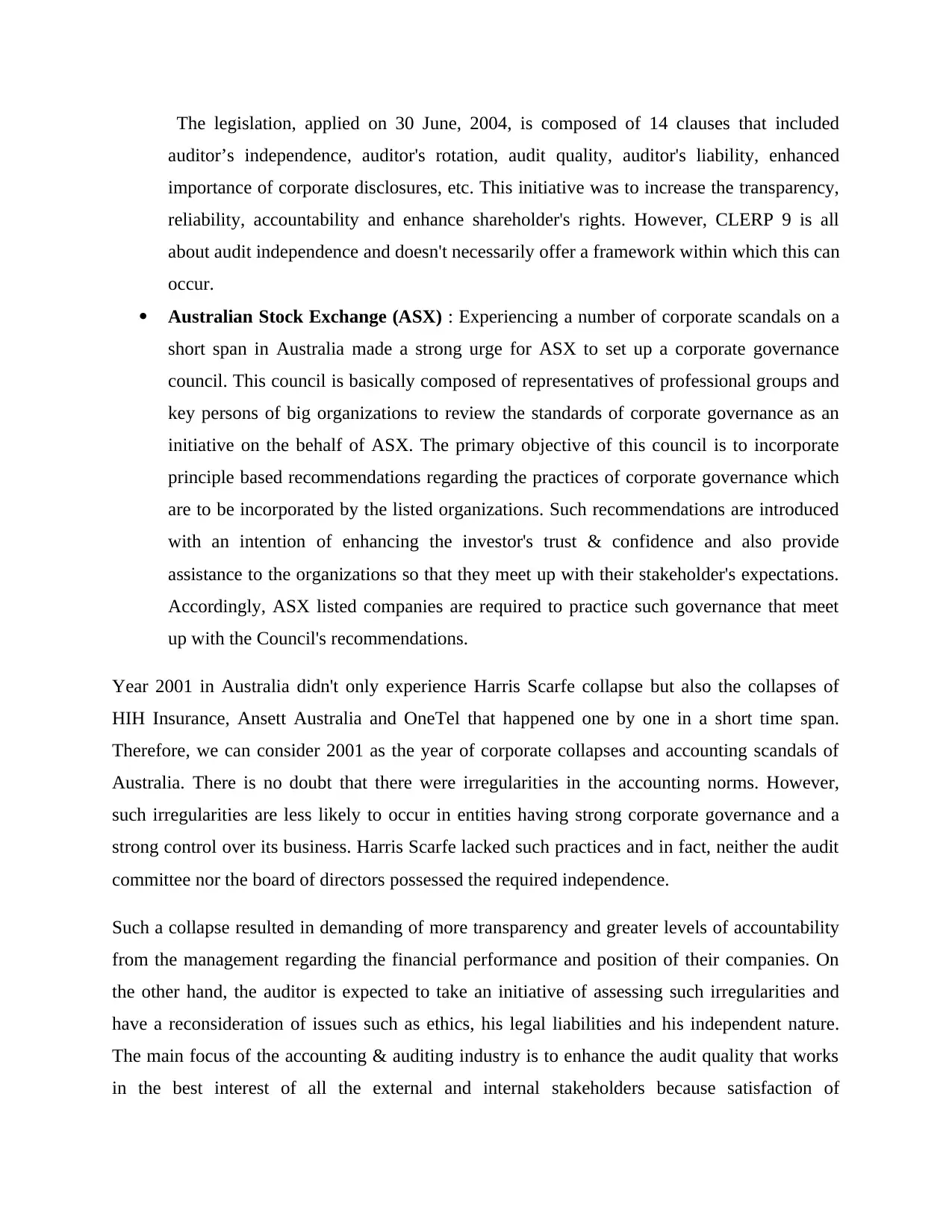
The legislation, applied on 30 June, 2004, is composed of 14 clauses that included
auditor’s independence, auditor's rotation, audit quality, auditor's liability, enhanced
importance of corporate disclosures, etc. This initiative was to increase the transparency,
reliability, accountability and enhance shareholder's rights. However, CLERP 9 is all
about audit independence and doesn't necessarily offer a framework within which this can
occur.
Australian Stock Exchange (ASX) : Experiencing a number of corporate scandals on a
short span in Australia made a strong urge for ASX to set up a corporate governance
council. This council is basically composed of representatives of professional groups and
key persons of big organizations to review the standards of corporate governance as an
initiative on the behalf of ASX. The primary objective of this council is to incorporate
principle based recommendations regarding the practices of corporate governance which
are to be incorporated by the listed organizations. Such recommendations are introduced
with an intention of enhancing the investor's trust & confidence and also provide
assistance to the organizations so that they meet up with their stakeholder's expectations.
Accordingly, ASX listed companies are required to practice such governance that meet
up with the Council's recommendations.
Year 2001 in Australia didn't only experience Harris Scarfe collapse but also the collapses of
HIH Insurance, Ansett Australia and OneTel that happened one by one in a short time span.
Therefore, we can consider 2001 as the year of corporate collapses and accounting scandals of
Australia. There is no doubt that there were irregularities in the accounting norms. However,
such irregularities are less likely to occur in entities having strong corporate governance and a
strong control over its business. Harris Scarfe lacked such practices and in fact, neither the audit
committee nor the board of directors possessed the required independence.
Such a collapse resulted in demanding of more transparency and greater levels of accountability
from the management regarding the financial performance and position of their companies. On
the other hand, the auditor is expected to take an initiative of assessing such irregularities and
have a reconsideration of issues such as ethics, his legal liabilities and his independent nature.
The main focus of the accounting & auditing industry is to enhance the audit quality that works
in the best interest of all the external and internal stakeholders because satisfaction of
auditor’s independence, auditor's rotation, audit quality, auditor's liability, enhanced
importance of corporate disclosures, etc. This initiative was to increase the transparency,
reliability, accountability and enhance shareholder's rights. However, CLERP 9 is all
about audit independence and doesn't necessarily offer a framework within which this can
occur.
Australian Stock Exchange (ASX) : Experiencing a number of corporate scandals on a
short span in Australia made a strong urge for ASX to set up a corporate governance
council. This council is basically composed of representatives of professional groups and
key persons of big organizations to review the standards of corporate governance as an
initiative on the behalf of ASX. The primary objective of this council is to incorporate
principle based recommendations regarding the practices of corporate governance which
are to be incorporated by the listed organizations. Such recommendations are introduced
with an intention of enhancing the investor's trust & confidence and also provide
assistance to the organizations so that they meet up with their stakeholder's expectations.
Accordingly, ASX listed companies are required to practice such governance that meet
up with the Council's recommendations.
Year 2001 in Australia didn't only experience Harris Scarfe collapse but also the collapses of
HIH Insurance, Ansett Australia and OneTel that happened one by one in a short time span.
Therefore, we can consider 2001 as the year of corporate collapses and accounting scandals of
Australia. There is no doubt that there were irregularities in the accounting norms. However,
such irregularities are less likely to occur in entities having strong corporate governance and a
strong control over its business. Harris Scarfe lacked such practices and in fact, neither the audit
committee nor the board of directors possessed the required independence.
Such a collapse resulted in demanding of more transparency and greater levels of accountability
from the management regarding the financial performance and position of their companies. On
the other hand, the auditor is expected to take an initiative of assessing such irregularities and
have a reconsideration of issues such as ethics, his legal liabilities and his independent nature.
The main focus of the accounting & auditing industry is to enhance the audit quality that works
in the best interest of all the external and internal stakeholders because satisfaction of
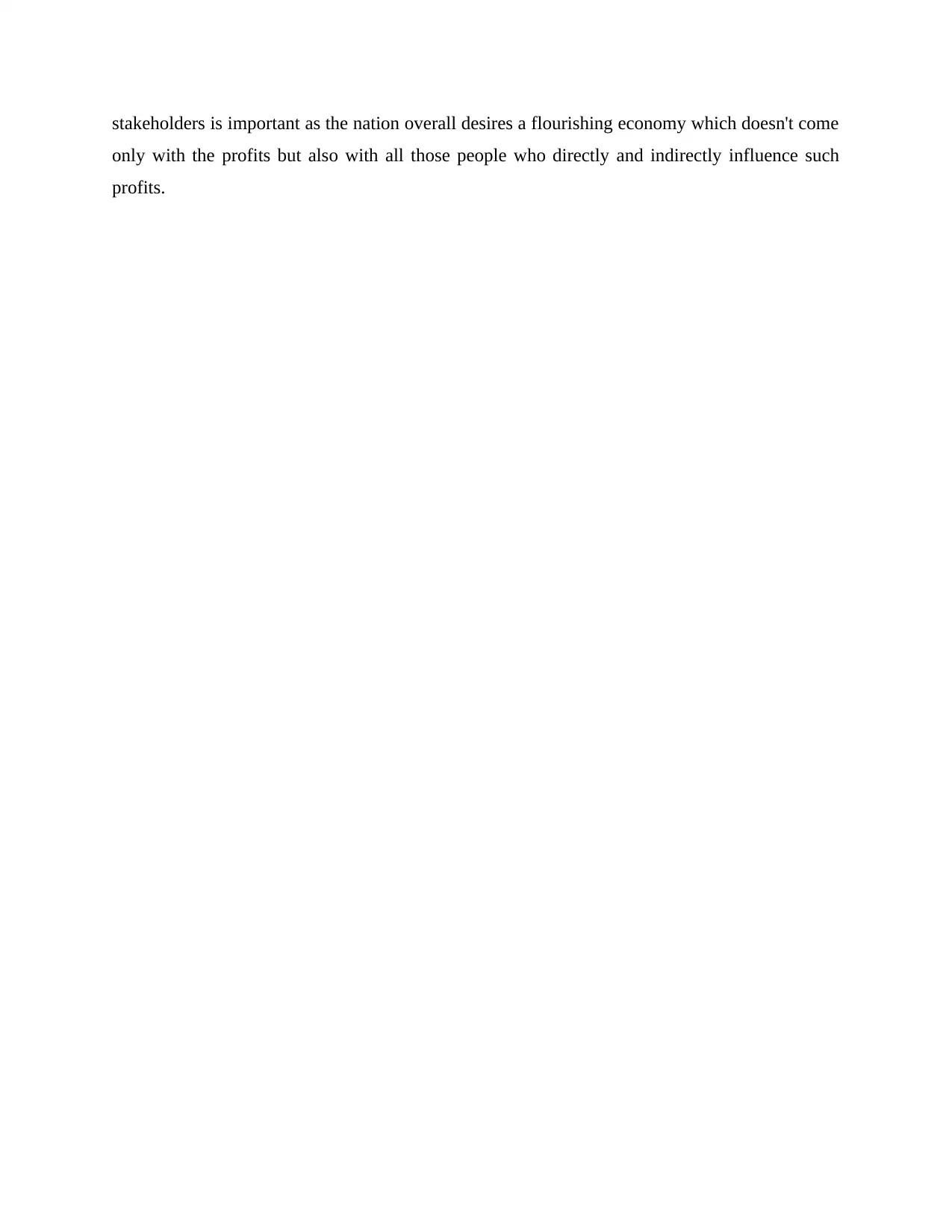
stakeholders is important as the nation overall desires a flourishing economy which doesn't come
only with the profits but also with all those people who directly and indirectly influence such
profits.
only with the profits but also with all those people who directly and indirectly influence such
profits.
Paraphrase This Document
Need a fresh take? Get an instant paraphrase of this document with our AI Paraphraser
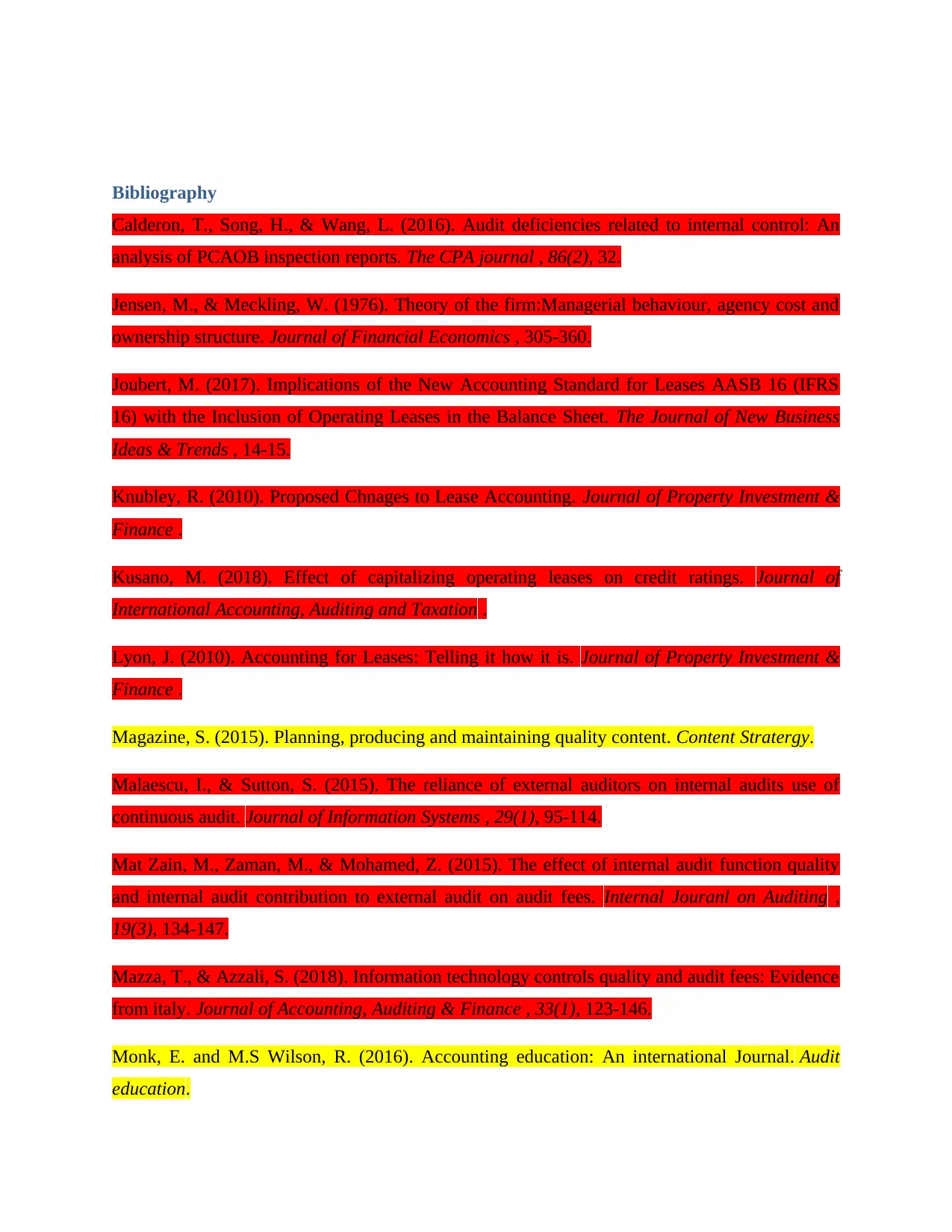
Bibliography
Calderon, T., Song, H., & Wang, L. (2016). Audit deficiencies related to internal control: An
analysis of PCAOB inspection reports. The CPA journal , 86(2), 32.
Jensen, M., & Meckling, W. (1976). Theory of the firm:Managerial behaviour, agency cost and
ownership structure. Journal of Financial Economics , 305-360.
Joubert, M. (2017). Implications of the New Accounting Standard for Leases AASB 16 (IFRS
16) with the Inclusion of Operating Leases in the Balance Sheet. The Journal of New Business
Ideas & Trends , 14-15.
Knubley, R. (2010). Proposed Chnages to Lease Accounting. Journal of Property Investment &
Finance .
Kusano, M. (2018). Effect of capitalizing operating leases on credit ratings. Journal of
International Accounting, Auditing and Taxation .
Lyon, J. (2010). Accounting for Leases: Telling it how it is. Journal of Property Investment &
Finance .
Magazine, S. (2015). Planning, producing and maintaining quality content. Content Stratergy.
Malaescu, I., & Sutton, S. (2015). The reliance of external auditors on internal audits use of
continuous audit. Journal of Information Systems , 29(1), 95-114.
Mat Zain, M., Zaman, M., & Mohamed, Z. (2015). The effect of internal audit function quality
and internal audit contribution to external audit on audit fees. Internal Jouranl on Auditing ,
19(3), 134-147.
Mazza, T., & Azzali, S. (2018). Information technology controls quality and audit fees: Evidence
from italy. Journal of Accounting, Auditing & Finance , 33(1), 123-146.
Monk, E. and M.S Wilson, R. (2016). Accounting education: An international Journal. Audit
education.
Calderon, T., Song, H., & Wang, L. (2016). Audit deficiencies related to internal control: An
analysis of PCAOB inspection reports. The CPA journal , 86(2), 32.
Jensen, M., & Meckling, W. (1976). Theory of the firm:Managerial behaviour, agency cost and
ownership structure. Journal of Financial Economics , 305-360.
Joubert, M. (2017). Implications of the New Accounting Standard for Leases AASB 16 (IFRS
16) with the Inclusion of Operating Leases in the Balance Sheet. The Journal of New Business
Ideas & Trends , 14-15.
Knubley, R. (2010). Proposed Chnages to Lease Accounting. Journal of Property Investment &
Finance .
Kusano, M. (2018). Effect of capitalizing operating leases on credit ratings. Journal of
International Accounting, Auditing and Taxation .
Lyon, J. (2010). Accounting for Leases: Telling it how it is. Journal of Property Investment &
Finance .
Magazine, S. (2015). Planning, producing and maintaining quality content. Content Stratergy.
Malaescu, I., & Sutton, S. (2015). The reliance of external auditors on internal audits use of
continuous audit. Journal of Information Systems , 29(1), 95-114.
Mat Zain, M., Zaman, M., & Mohamed, Z. (2015). The effect of internal audit function quality
and internal audit contribution to external audit on audit fees. Internal Jouranl on Auditing ,
19(3), 134-147.
Mazza, T., & Azzali, S. (2018). Information technology controls quality and audit fees: Evidence
from italy. Journal of Accounting, Auditing & Finance , 33(1), 123-146.
Monk, E. and M.S Wilson, R. (2016). Accounting education: An international Journal. Audit
education.
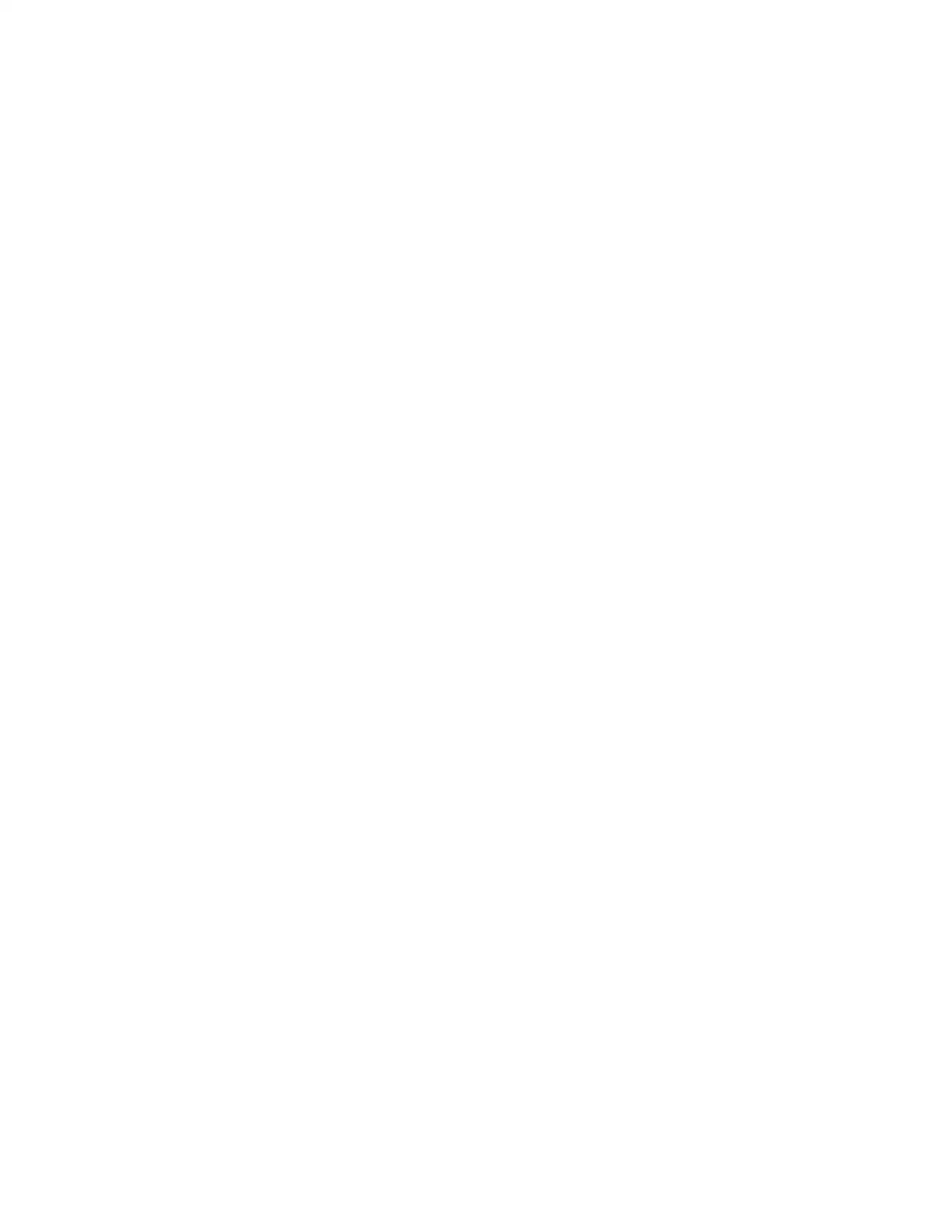
1 out of 9
Related Documents
Your All-in-One AI-Powered Toolkit for Academic Success.
+13062052269
info@desklib.com
Available 24*7 on WhatsApp / Email
![[object Object]](/_next/static/media/star-bottom.7253800d.svg)
Unlock your academic potential
© 2024 | Zucol Services PVT LTD | All rights reserved.




